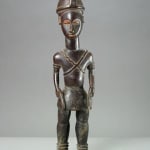Baule Wooden Colonial Sculpture, 20th Century CE
Wood
3.5 x 14.25
PF.5911
Further images
African artists have long compromised their tribal integrity in order to appease the tastes of European patrons. Perhaps most famous are the ivory salt cellars Benin artists carved specifically for...
African artists have long compromised their tribal integrity in order to appease the tastes of European patrons. Perhaps most famous are the ivory salt cellars Benin artists carved specifically for Portuguese traders replete. These intricately crafted vessels are decorated by representations of Portuguese traders wearing characteristic armor and jewelry including crosses. These Benin carvers utilized their same artistic tradition to create products designed to appeal to Western tastes. Much as Benin artists of the 16th and 17th centuries created works for consumption by the Portuguese, African sculptures of the 20th century created sculptures to appeal to the tastes of their colonial rulers. At the close of the 19th century, European powers dashed to claim territorial rites to the African continent before rival powers did first. These “spheres of influence” which would evolve into full-fledged colonies, were propelled as much by domestic rivalries as an insatiable thirst for exploiting the vast mineral and natural wealth of Africa. By the 1920’s, the artist of the Western coast had begun to create a type of art that would come to be known as colonial. These works often depicted traditional African sculptural types dressed in the costume of a typical colonial tourist. Often whimsical and charming, colonial sculptures abandoned the traditional tribal aesthetic in exchange for brightly painted colors and realistic modeling that attracted European collectors. This sculpture, although it is not painted, reveals a clear attempt on the part of the artist to appeal to the tastes of colonial tourists anxious to pick up a souvenir of their journey. The western influence is most evident in the subdued facial features of this figure. Gone are the scarifications that would identify this figure as belonging to the Baule tribe. In its place is a sweet smile and rounded, smooth features. Besides the decorative armbands and anklets, there little evidence of the tribal style in this work. Perhaps most revealing is the figure’s cap. This rounded hat is a stylized version of the typical bucket safari hat. Overall, this work reveals as much insight into the history of the continent as the oldest tribal sculpture.









